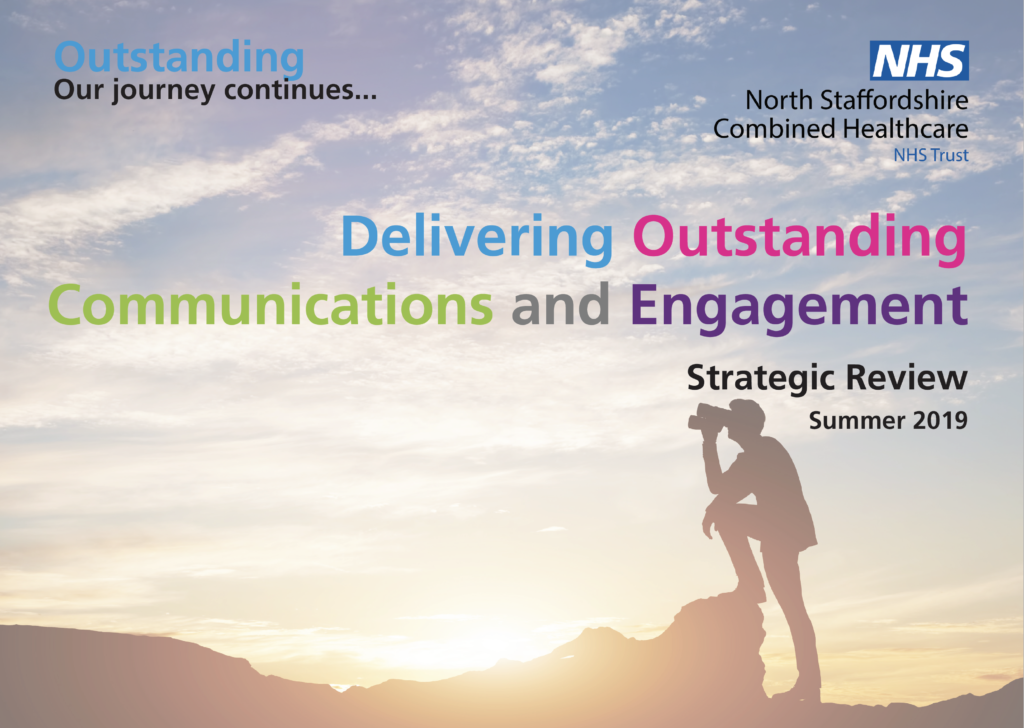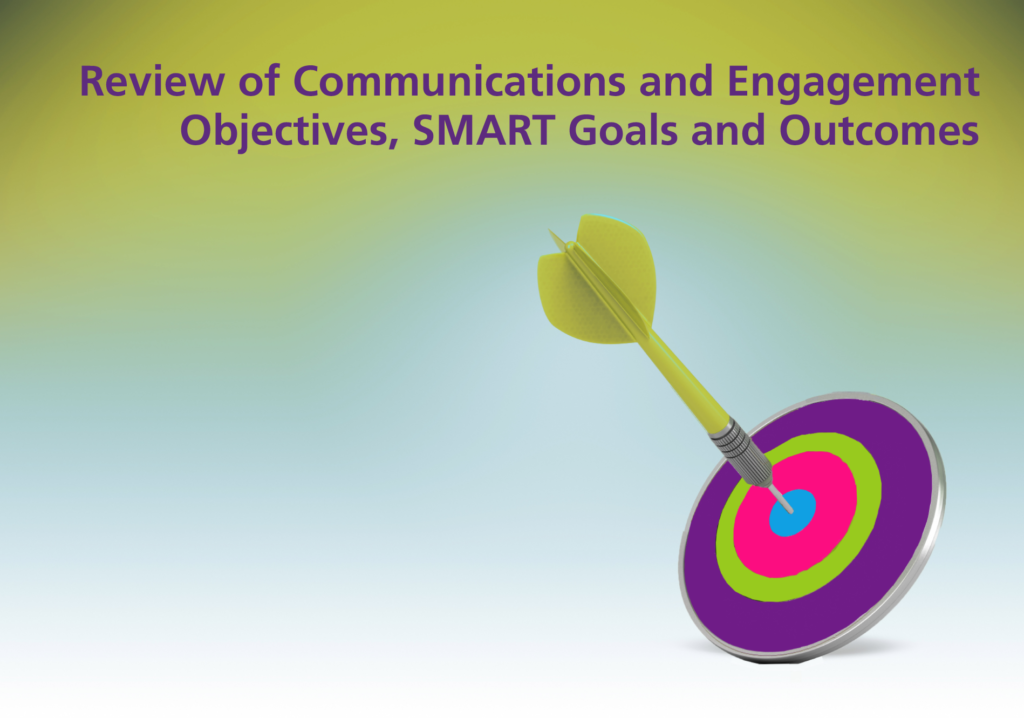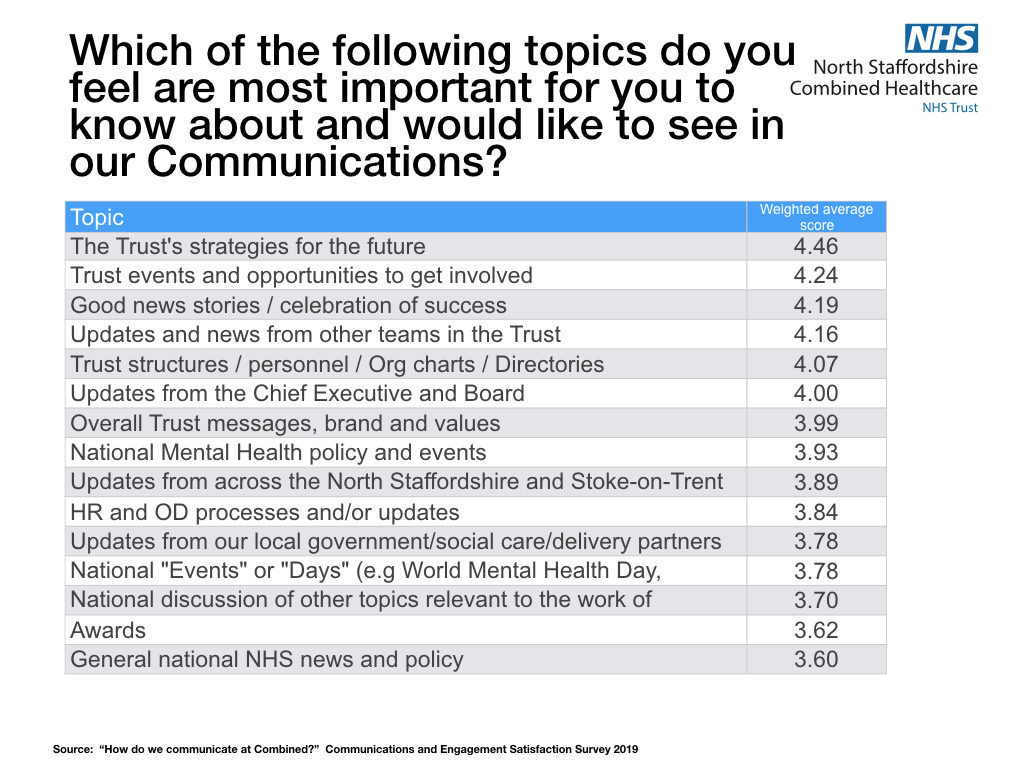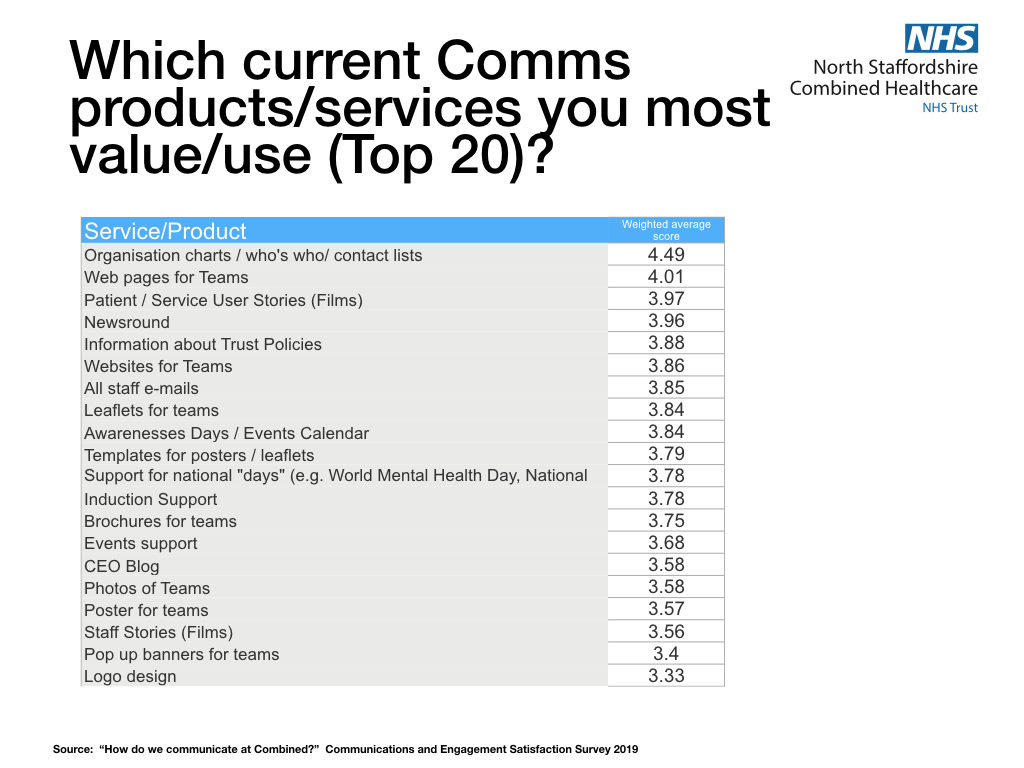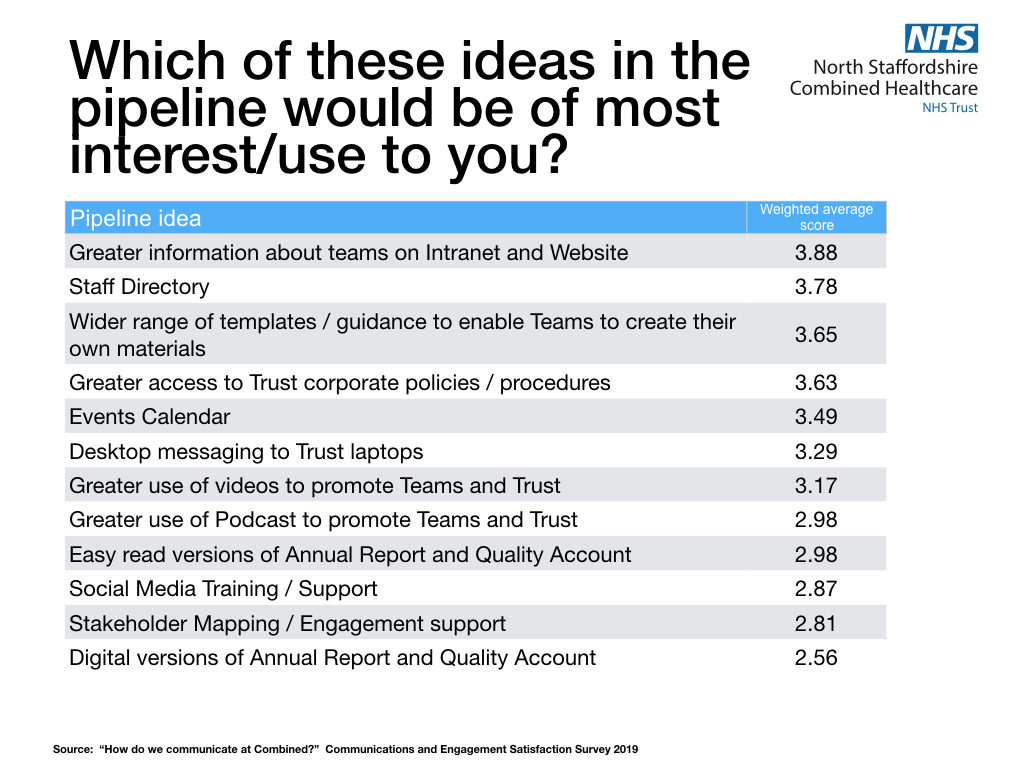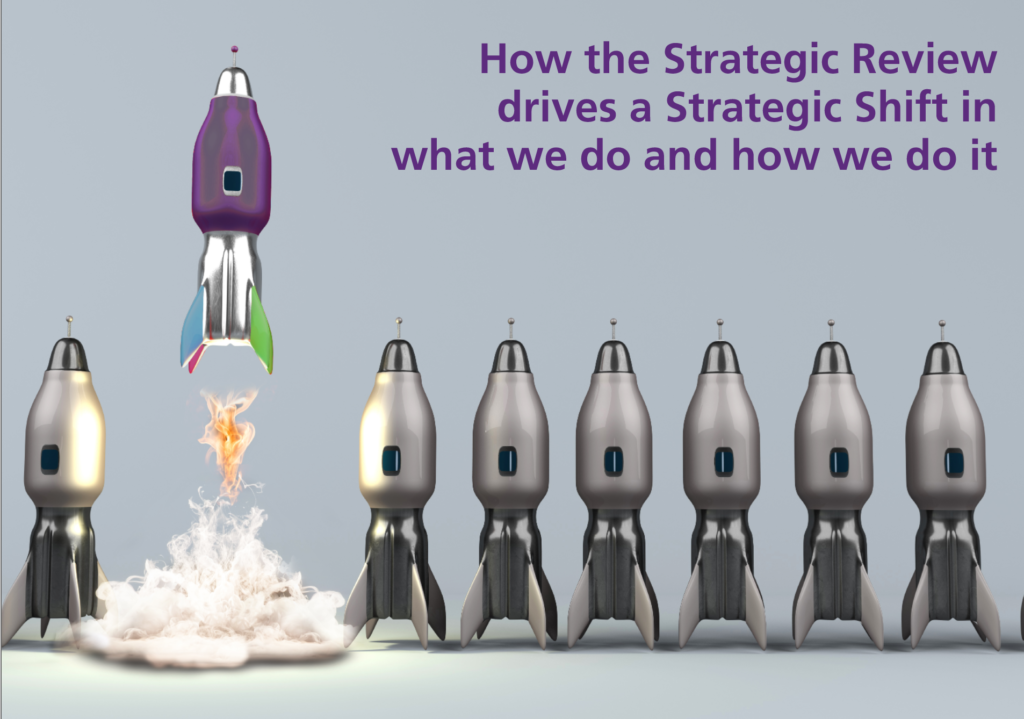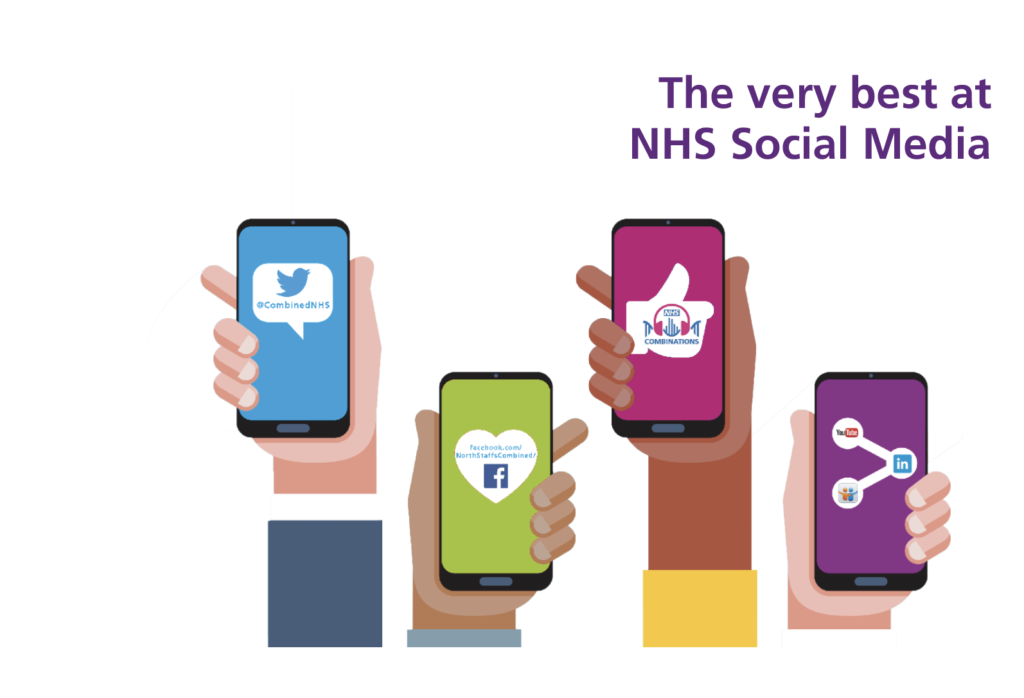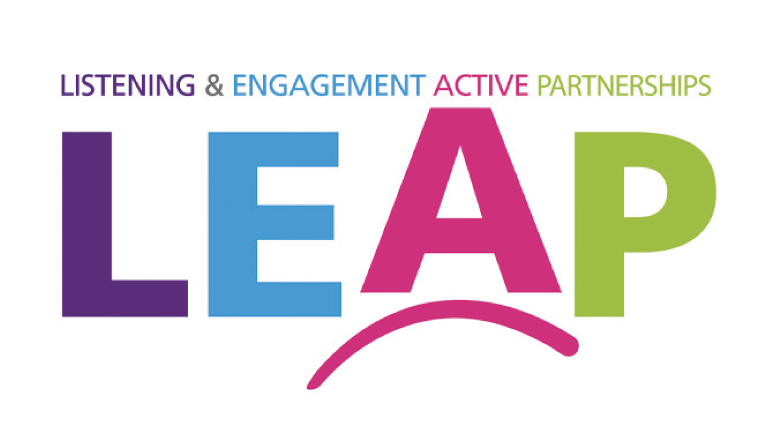In September 2019, the Trust Board approved the findings and recommendations of the Strategic Review of Combined Healthcare Communications and Engagement.
You can click on the image below to download a PDF copy of the whole Review.
Or you can link from each key finding to the relevant section of the Report set out on this page.
Key findings
Objectives
SMART Goals and Outcomes
Raise the quality of communication and engagement channels to match the Trust’s ambitions set out in its vision and objectives – thereby raising its reputation, aiding staff retention and attracting the best staff
Build and promote a strong profile of the Trust locally and nationally through a distinctive design style within the NHS brand and compelling narrative to create greater awareness, confidence and relationship with stakeholders particularly people who need the Trust’s services
Improve the reputation of the organisation locally, regionally and nationally
Support the Trust to become a national leader in digital technology and for all the stakeholders to understand the benefits and be engaged
Strengthen relationships with partners (particularly primary care) and collaborate on promotion of joint developments in integrated care
Raise awareness of the Trust’s services and how to improve wellbeing across online and offline channels with increasing use of digital media
Involve and inform Trust staff in the vision and the direction of the organisation enabling them to contribute and understand how their roles support the success of the Trust and the impact on our patients
Aim to raise the Trust’s staff engagement score year on year by ensuring their views are heard, seeking their feedback, listening, empowering, and responding to make a difference to their working life (to be achieved jointly with the Trust’s People Strategy).
Ensure users of our services are involved in the design and development of external communications
Evaluate and measure communication performance
Return to top of page
Increase the number of organisations and people with whom we communicate by at least 25% using a baseline including social media reach and subscribers to e-newsletters
Widen the range of voices and perspectives which we hear, in particular going beyond the normal NHS and social care ‘family’ to engage people in their wider lives and activities – including those in seldom and/or less heard groups – by adding at least 2 new organisations in each identified category
Increase the quality of our communications outputs and activities, the experience of those with whom we communicate and our ability to deliver communications which better meet the diverse needs and preferences of all service users and stakeholders – through the introduction of an Annual Communications Satisfaction survey and insights from focus groups involving both a wide range internal and external audiences
Increase the ease with which people can receive communications from us and communicate with us – through the introduction of new, free subscriber services via our website, expanded e-newsletters and new Podcast channel
Increase the accessibility of our communications outputs through new Easy Read and multi-language versions of our website and key Reports, plus new interactive audio and video versions of their content
Increase the quality and efficiency of the digital estate through the implementation of a new combined Internet, Intranet and other web presences
Make our social media the best in the NHS through benchmarking and development of a Social Media Optimisation Plan
Increase the proportion of our communications activity related to providing advice, signposts and support – by creating support materials and resources available via our website and distributed to local organisations and companies
Increase our public profile and reputation with regional and national organisations and opinion formers – through the introduction of Listening and Engagement Active Partnerships with the communications teams in key national organisations in areas relevant to our services and service users
Actively support promotion of our Directorates and/or Locality Teams with the aim of increasing by 25% the number of high quality entries the Trust makes to national and regional Awards
Increase the immediacy and impact of our direct communications to staff – through the introduction of new capabilities to centrally manage and disseminate key messages via screensavers, remotely managed TVs located in business locations and desktop wallpaper to staff devices
Support key aspects of Trust operations – including finance, performance, governance and digital teams – through introduction of new data management, analysis and reporting tools
Protect and promote the Trust’s external reputation and strategic effectiveness in influencing – through increased proactivity and effectiveness in stakeholder management and public affairs
Contribute to effective mitigation of key Trust risks – for example in recruitment and retention, through active liaison with the Trust management lead, senior leadership team and Executive Directors
Support the Trust’s organisational and business development strategies – by mapping new organisational structures and activities against business development goals and developing bespoke communications and marketing materials and strategies for each area of activity
Return to top of page
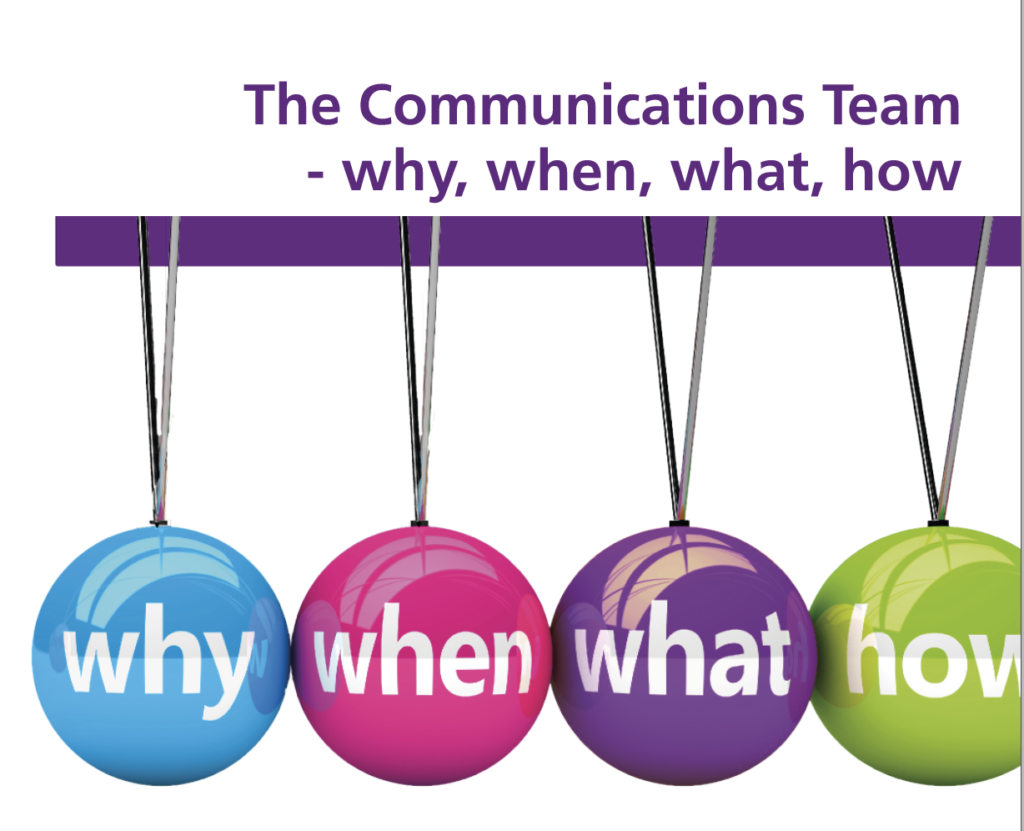
Return to top of page
Sustained investment and improvement over nearly three years in Combined Communications and Engagement has delivered improvements in:
- team skills and capabilities;
- hardware and software;
- channels and services;
- products and tools; and
- events and activities.
As a result the Combined Healthcare team and operation now matches – and in most cases exceeds in-house – all of the industry-standard, best-of-breed skills, equipment, products, channels and capabilities that could be offered by any private sector PR or marketing agency, public affairs firm or Commissioning Support Unit.
Skills available within the Comms Team to support the Trust
Audience research – Branding – Business Process Mapping -Campaign Design and Delivery – Copyrighting – Crisis Management – Customer Relationship Management – Data analysis – Design Consultancy – Desktop Publishing – Digital Design – Events Design and Production – Film Production – Logo Design – Market Research – Marketing – Media Relations – Media Training – Podcasting – Public Affairs – Public Relations – Reputation Management – Social Media – Staff Engagement – Stakeholder Engagement – Survey Design and Delivery – Video Production – Website design and management
Capabilities delivered and available
Audience Identification and Building – Banners – Brochures – Campaigns – Campaign Analytics – Conference design and Delivery -CRM – Database design and management – e-marketing – e-newsletters – Digital Content – Events – Film and Video – Horizon Scanning – Leaflets – Livecasts and Live Broadcasting – Logos – Newsletters – Outside Broadcast – Photography – Podcasts – Posters – Promotional Materials – Real time Touchpad Voting – Reports – Social Media Content – Surveys – Syndicated web content – Websites and web content
Channels and Services
- CEO Blog
- CEO Board Report
- Combinations Podcast (iTunes and Soundcloud)
- Dear Peter
- Intranet (CAT)
- Newsround
- Slideshare
- Team Brief
- YouTube
- Website (main website)
- Website (Microsites)
By combining these skills, capabilities, channels and services , we have been able during 2018/19 to deliver an Outstanding Year of Communications for the Trust and its teams.
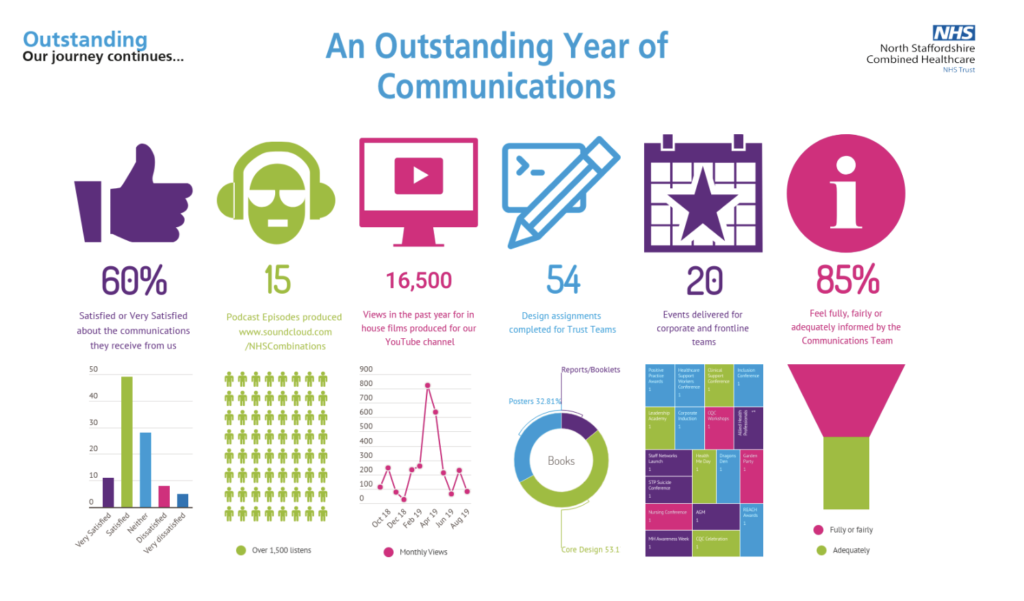
“Combinations Podcast”
Our staff, service user and carer stories were further enhanced by the launch of our Combined Healthcare Podcast – called ‘Combinations’ and accessible for free at https://soundcloud.com/nhscombinations and live, free subscription on iTunes.
The first Episode was launched on 7th February 2019 to coincide with national mental health “Time to Talk Day” and featured our CAMHS team talking about their nationally leading service, investments, new staff, new services, and partnership with schools, CAMHS Trailblazer and a NHS Digital Exemplar.
Since then episodes have included:
- The Jam Factory – highlighting a group collective based at the Observatory in Hanley Stoke-on-Trent welcoming individuals of all different abilities who have experience of mental ill health;
- Jackie and Mathew’s Story – Jackie describes the care and support she and her son Mathew – who has autism and severe learning disabilities – have received from our Assessment and Treatment Unit at Harplands Hospital;
- Self-managed relaxation session – provided by Staff Counsellor and Support Officer, Sarah Tombs, available for anyone to use as a free resource and as part of our overall mission to promote good mental health and wellbeing for all;
- Ramadan Mubarak – a group of Muslim members of our staff discuss the fundamentals of Ramadan, how it fits with the wider pillars of the Islamic Faith and how non-Muslim staff can show their support to their colleagues during this special time for them;
- Suicide Awareness Training and Learning Disability – Felicity Watkin and Phil Emery from our Learning Disability service tell us of their groundbreaking work – in collaboration with service users – to further adapt an innovative Suicide Awareness Training tool -to make it even more relevant to people with Learning Disabilities;
- Maria and Jack’s Story – Maria tells the tale of a lifetime of engagement with our CAMHS service, supporting her and her 18 year old son Jack, who has autism and epilepsy, and who was diagnosed with cerebral palsy aged 8 month;.
- The Talk and Change Group – To mark Learning Disability Week 2019, a special feature on the Talk and Change Group a service user group aligned with our Learning Disability Team; and
- Staff Nurse Story – One of our most important priorities is improving the support for our BAME workforce. One very brave nurse who worked in our services shared her story with us which a local poet interpreted.
We will continue to produce regular podcasts on items of interest plus investigate material produced by our stakeholders and broadcast by us. Crucially, when we work with stakeholders to produce material giving their own views and those of their members, prime editorial direction will be with the stakeholder, not ourselves (subject of course to normal legislative standards). In this way, we can ensure the patient and stakeholder voice remains vibrant and genuine.
Return to top of page
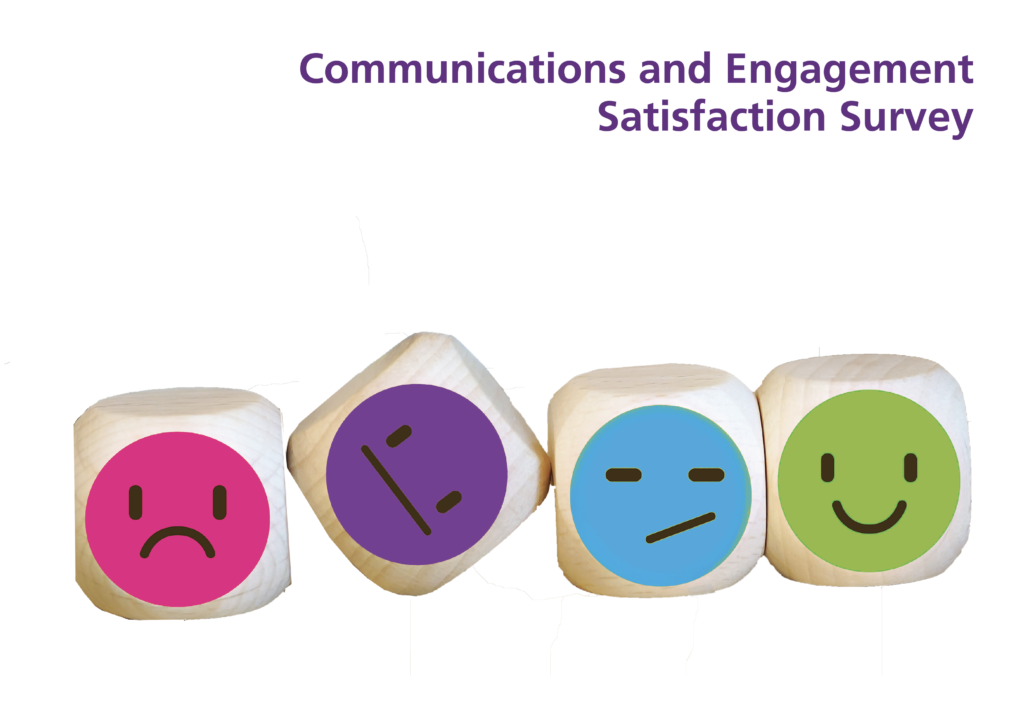
Key messages
The Communications Satisfaction Survey provides welcome reassurance that the investment and work carried out over the last three years has delivered results in terms of satisfaction from staff, service users and stakeholders.
Overall, people feel well supported and informed by the Communications and Engagement Team and the channels designed, operated and managed by them.
The team is seen as approachable, responsible and excellent – in line with the Trust Proud to CARE values. They are also seen as positive and friendly. There is recognition of the improvements, progress and new channels delivered over recent years.
There is a strong theme that comes through of the value that is particularly attached to products and services that provide information and celebrate achievements about frontline teams.
The need and desire for greater information and support relating to content and operations of frontline teams – as well as an ever greater focus on surfacing and celebrating achievements and activities at the team and directorate level – also come through strongly in the ranking of future ideas in the pipeline.
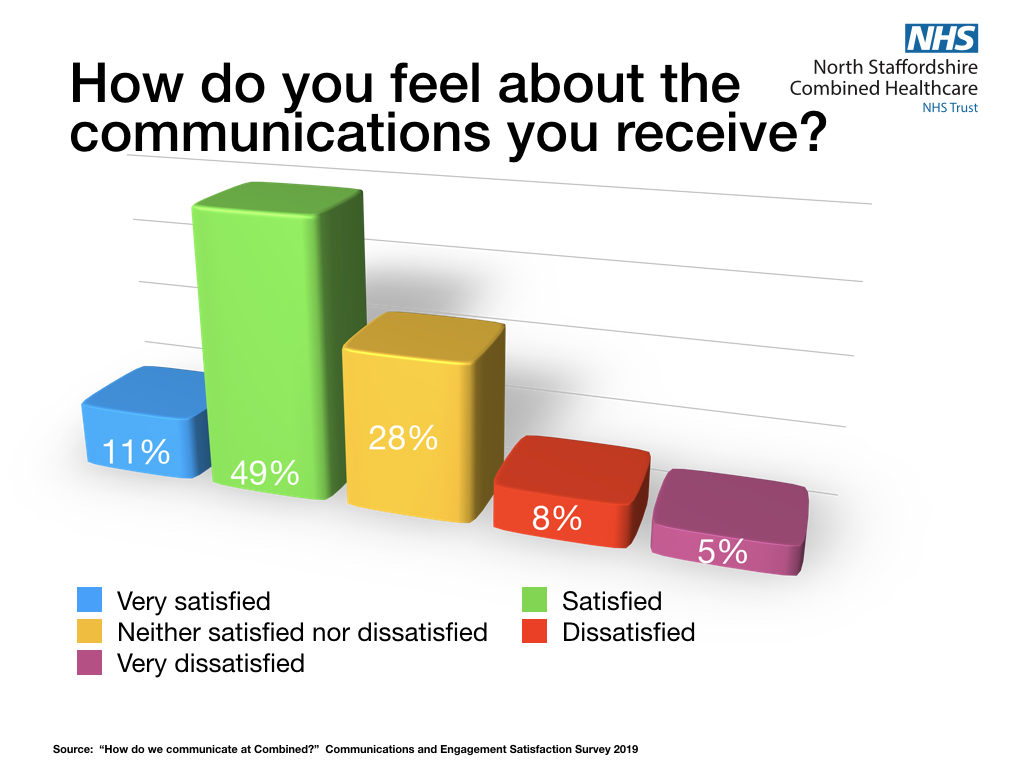
“The team are very responsive and supportive” Care Home Liaison Team
“Great improvements made” Staff Counselling
“The Combined Comms Team are the most approachable, helpful, innovative, passionate and forward-thinking communications team I have worked with.” OD and Education Team
“We work with Combined to ensure consistent shared messages about services are delivered to the public, when responding to press enquiries or promoting services. We find the communications team responsive and helpful.” Stoke City Council Pubic Health
“I think that there are a lot of comms that could go out centrally but often response has been slow due to demand / resource issues…I would like more clinical/front line information shared rather than just Top Down” Harplands Acute Wards
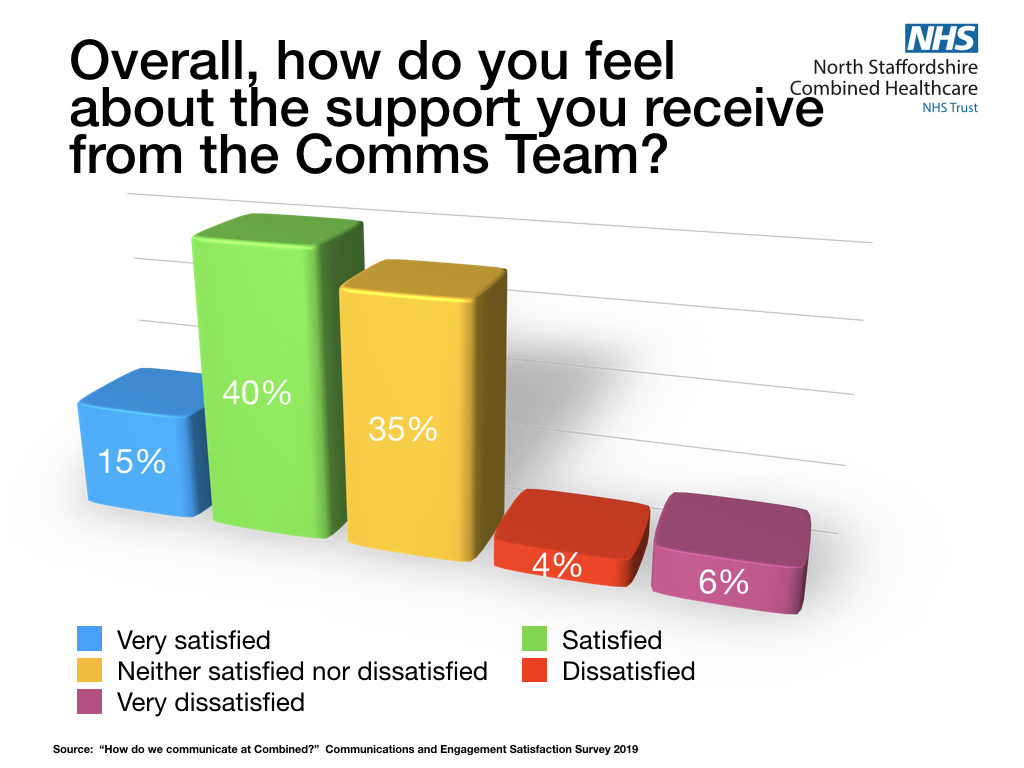
“Good selection of ways of communication both internally and externally and good use of social media”Service Manager
“Relevant information is received where necessary. It is also good to see representation from communications at some meetings to facilitate what is shared as outcomes from those meetings e.g. the recent power outage” Intensive Support Team
“The comms team are often relying on staff giving them content for any comms to go out which takes time.. .so Twitter often seems to provide better snapshot info re what’s happening in the Trust as its quicker for staff” Patient Sefety Manager
“You can never tell us everything but I like the positive vibe that comms have adopted. It’s good for morale” – Mental Health Liaison Team
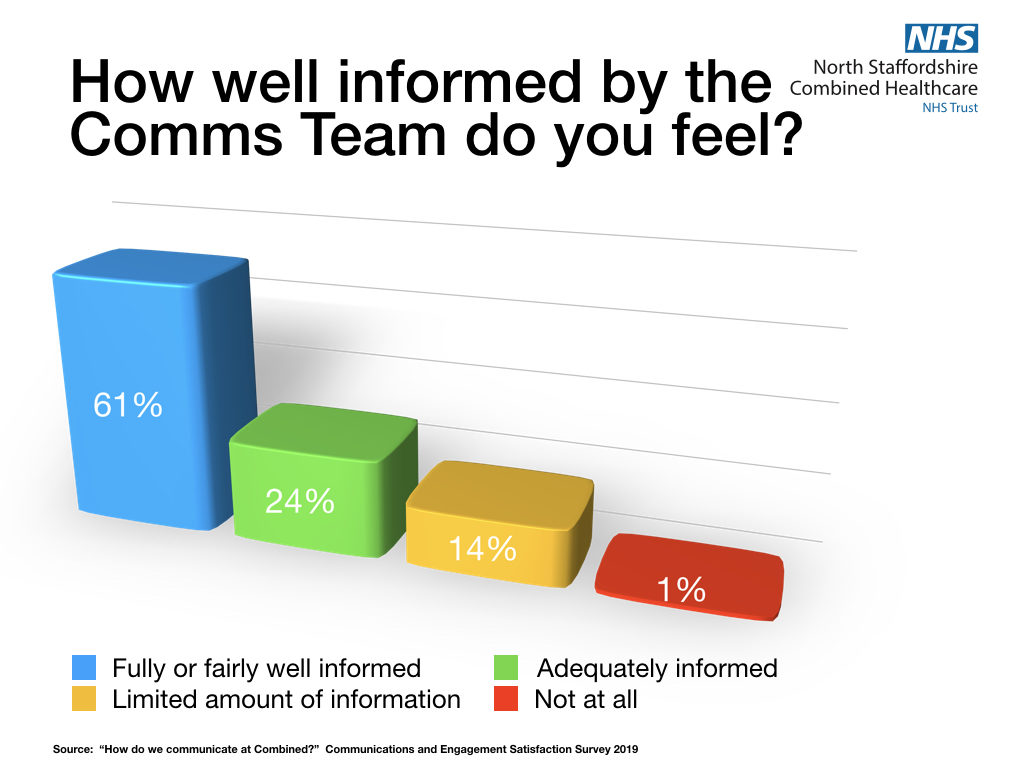
“I generally feel that communication is timely, relevant and communicated widely. The only thing I feel people would like to know more of is regarding the plans to develop/ enhance clinical services. Maybe more communication from a commissioning point of view would help.”Social Worker AHMP
“More information about the different services would be great, as there is so many different ones and unless there is an event, we do not hear anything of them. Corporate
“Really difficult to get a balance between too much information coming out and not enough time to read it and keeping more informed. Like the headlines with links to click for further information” Learning Disabilities Service
“Ideally, if we could utilise the computer opening screen for the Trust for comms – then we could get short, snappy comms out to everyone” Education and Development Manager
Return to top of page
Priority Areas
Reviewing progress in implementing the 2018-20 Delivery Plan, and taking into account the findings of the Satisfaction Survey, the Strategic Review suggests the following areas need priority attention and can be delivered without the need for extra investment:
- complete the implementation and population of the Trust Intranet (CAT);
- introduce a new staff directory and events calendar on CAT;
- a particular focus on supporting recruitment and retention;
- improve the current function on CAT for supporting Trust Policies and Procedures;
- improve the quality and currency of information available about Trust Teams and the new locality structure on both CAT and the Trust public website;
- increase the use of video, digital and social media friendly material and content;
- develop a comprehensive set of core templates, style guides and support materials to enable Teams to be more self-sufficient within brand guidelines;
- complete introduction of monitors with core Communications messages in Trust locations other than Lawton House and Harplands Hospital;
- complete introduction of Trust-wide desktop messaging solution;
- complete implementation of active stakeholder management, underpinned by MOOD;
- develop the potential of the MOOD solution to support key aspects of Trust operations (in particular programme and project reporting and system landscape understanding) through supporting introduction of new data management, analysis and reporting tool; and
- introduce full range of Listening and Engagement Active Partnerships (LEAPS).
Return to top of page
Recalibration
Taking into account the changing landscape and organisational context within which Combined is operating compared with 2016-2018, together with the findings of the July 2019 survey, the following recalibrations would suggest themselves to be beneficial:
- an even greater emphasis on promoting and celebrating team and directorate level activities and achievements;
- a higher profile presence amongst locations other than Lawton House and (to a lesser extent) Harplands Hospital;
- a greater emphasis on the role of the Communications Team in supporting self-sufficiency and developing proficiency and activity by frontline teams and individuals, compared with centrally producing material – including greater understanding and use by frontline staff of video, social and digital media and content;
- an increased emphasis on the role of the Trust Intranet and public website for day to day news promotion, augmenting social media activity;
- a greater exploitation of existing material through making them available by default via social and digital channels (e.g. introducing Slideshare into our channel portfolio and more use of livecasting/recording)
- a greater emphasis on the day to day stakeholder management, public affairs and engagement elements of the Communications Team’s function; and
- a particular focus on building up audiences and take-up of “push notification” channels (e.g. Twitter, Facebook, LinkedIn, Podcast, Slideshare and e-newsletter).
Return to top
Elements of Strategic Shift
The overall thrust and intent of the Strategic Review goes beyond specific goals and outcomes. It provides a coherent, integrated approach which is designed to achieve a strategic shift in the way we approach our communications and engagement.
The first part of this strategic shift is called “Active Listening”. This means having a continual awareness that we don’t just listen and communicate for the sake of it or as an end in itself, but in order to deliver – and be seen to deliver – concrete outcomes and improvements in our strategies and the recovery-focussed services we seek to deliver for local people, incorporating their views, insights and preferences.
It also includes providing advice and information, signposts and support to enable people to look after their own health and well-being and that of the people they care for.
Return to top of page
The second part of this strategic shift is called “We come to you”. This means that we do not expect any of our service users or stakeholders to have to make specific effort to come to our websites or online presences or attend one of our events to find out what is going on and/or whether something is happening or available that may be of interest in importance to them. Instead, we will create free subscription services, e-newsletters, podcasts and social media to deliver content direct to people in their own hands, increasingly via their mobile device or e-mail, also working with colleagues and partners to complement these channels with offline activities to ensure that our approach does not cause digital exclusion.
Return to top of page
The third part of this strategic shift is a conscious planned effort to go beyond our traditional audiences and the NHS ‘family’ to reach out to wider voices, perspectives and opinions. We do this by increasing both the depth and the width of our engagement reach. In particular, we have two aims:
- increase the number of people with whom we engage within those organisations with whom we are already engaged; and
- increase the range of organisations and individuals with whom we engage, going beyond the normal NHS ‘family’ to engage people in their wider lives and activities.
Return to top of page
The fourth part of this strategic shift is a determination to deliver the highest quality and most modern communications possible. We do this by deploying best of breed’ tools, infrastructure and capabilities, by introducing new surveys and focus groups to test our delivery and performance, by increasing the quality and efficiency of our digital estate and setting ourselves an ambitious goal of becoming the very best at NHS social media.
Return to top of page
Active Listening
At the heart of our strategy lies the concept of Active Listening and Communications. This can also be described as “listening and communicating for a purpose”. This includes listening to the views of and communicating with:
- our service users and their carers and families;
- our own staff;
- local NHS and care partners, including via initiatives such as the North Staffs GP Federation and the North Staffordshire and Stoke-on-Trent Alliance;
- our partners across the local Staffordshire and Stoke-on-Trent Sustainability and Transformation Partnership, including our local government colleagues;
- local voluntary and third sectors;
- print and broadcast media
- local businesses and employers;
- local decision makers, elected representatives and opinion formers; and
- audiences and communities active on social media.
It means having a continual awareness that we don’t just listen and communicate for the sake of it or as an end in itself, but in order to deliver – and be seen to deliver – concrete outcomes and improvements in our strategies and the recovery-focussed services we seek to deliver for local people, incorporating their views, insights and preferences.
It also includes providing advice and information, signposts and support to our staff as well as local service users and carers to look after their own health and well-being and that of the people they care for.
We look to deliver the concept of Active Listening in reality through:
- the establishment of new Listening and Engaging Active Partnerships (LEAPS) with key stakeholders and partners – locallyl, regionally and nationally;
- strengthening and deepening our ties and planned activities with local Healthwatch and the voluntary sector;
- strengthening our drive to engage seldom heard groups and ensuring that their voice is heard and acted upon;
- reaching out beyond our immediate and familiar networks in health and social care to embrace and engage with organisations and individuals involved in complementary networks and interests – for example in environmental, sporting, cultural and educational spheres;
- developing our relationships and joint working with communications team in local government;
- strengthening our partnerships and relationships with local print and broadcast media, including BBC Radio Stoke, Signal Radio and the Stoke Sentinel; and
- increasing our profile and activities with local businesses and employers, helping provide advice and signposts to their own employees on how to access and use our services for themselves and their families.
Return to list of elements of Strategic Shift
“We come to you”
A key plank of our updated Communications Strategy is a determination to ensure that people shouldn’t be forced to come to us to find out information, give their views and opinions, nor to make their voice heard. Instead, we will make strong efforts to go to them and enable them to proactively receive communications from us.
We do this by:
- introducing a new facility via our website to allow users to receive automatic alerts of news items as soon as they appear, or in a daily or weekly summary;
- increasing our use of social media in ways that go beyond merely using it as another publishing channel. Rather than using social media simply to tell the NHS, social care and the wider world what we are doing and what we are thinking, we look to use social media to give frontline staff, carers, patients and families their voice and their spaces to interact with us and each other;
- increasing our use of e-newsletters to which anyone can subscribe and automatically receive. Increased use of this channel also enables us to track how many recipients read the content and/or activate links to material contained therein;
- creating a new podcast channel “Combinations” via iTunes and Soundcloud, containing audio and video news items from the Trust plus background films introducing our people and partners and explaining what we do. Always available to anyone and always free, any episode is capable of being watched online or downloaded without subscribing. Subscribers automatically receive new episodes to their computer or mobile device. We produce regular podcasts on items of interest plus the possibility in future of material produced by our stakeholders and broadcast by us. We will work with them to agree what topics they would most like us to produce with them or what programmes and material they would like to see
- identify and approach followers of Twitter accounts that demonstrate a relevance to our target areas but do currently follow our own Twitter account using a unique social media intelligence tool – Find SoMeOne in Health. This enables us to engage via Twitter with audiences who would not normally feature on our radar or whom may not be aware of what we do and/or hear messages and information from us that would be of use and help;
- use a unique facility on our website and/or Intranet – Windows on the World – bringing together real time content produced by pre-selected Twitter accounts, Facebook Pages and Instagram. They enable users to see and interact with what is being talked about right now on social media by different worlds of individuals, organisations and groups.
Return to list of elements of Strategic Shift
Increasing our reach
Historically, our reach was built on the following main strands:a membership database, initially created with the help of an external supplier in 2016, but brought in house in 2017;
- a stakeholder list made up of 254 key stakeholders mainly from NHS organisations across the local health economy, refreshed and confirmed by the Communications Team during 2017;
- our staff list held by HR and updated to Communications Team monthly for distribution of the CEO blog, Newsround and staff notifications;
- our Service User and Carer Council;
- attendee invites to various annual, engagement and/or Open Space events; and
- individual and/or ad hoc lists held by directorates or teams across the Trust
As part of the update Communications Strategy 2018-20, we have begun to increase both the depth and the width of our engagement reach. In particular, we are pursiong two aims:
- increase the number of people with whom we engage within those organisations with whom we are already engaged; and
- increase the range of organisations and individuals with whom we engage, in particular going beyond the normal NHS ‘family’ to engage people in their wider lives and activities.
Increasing the numbers
To help us achieve our first aim, during 2018, we integrated into our new MOOD tool the management and operation of the hitherto separate externally hosted databases underpinning our membership scheme and our service user and stakeholder groups. This will give us greater ability to track and understand how many people we know about within each organisation with whom we engage.
At the end of this exercise, we had increased our database of named stakeholders from 254 to 408.
We also had created a list of 173 stakeholder organisations, grouping them according to their organisation type:
- Patients – Carers – Families
- Health and Care Partners
- Media – Opinion Formers – Influencers
- Companies and Partners
- Elected representatives and oversight
- Third Sector and Community Groups
We also grouped the organisations/groups according to geogrpahical proximity – whether they were:
- Internal to the Trust
- Local
- Regional
- National
This exercise has already shown gaps and potential inaccuracies in our existing stakeholder lists – for example it suggests that our tagging of stakeholder organisations may need improvement.
We will:
- carry out a full data cleanse of our stakeholder individual and organisational contAct details and categorisation;
- once this is completed, we will analyse where we have significant gaps across organisation type and proximity;
- prioritise filling these gaps as part of our greater emphasis on the day to day stakeholder management, public affairs and engagement elements of the Communications Team’s function
We will also systematically work through our records of stakeholder organisations, using the named contact or generic e-mail account as a bridgehead into the organisation’s wider membership, offering them the opportunity to engage with us direct.
We will in particular strengthen our drive to engage seldom heard groups and ensure that their voice is heard and acted upon. Some of these groups may well prefer us to engage with a single named contact and to give us their views and experiences via face-to-face activities. The important thing is for us to consciously be aware of and document these preferences, so we can ensure we are really meeting people’s preferred options.
Increasing the range
Like most NHS organisations, the vast majority of our engagement takes place with people within the context of our day-to-day business or their own direct recent experience of care
This is – and should remain – the core of our listening and engagement activity. It enables us to understand the views and experiences of those currently using and experiencing our services. And it forms a vital part of our quality strategy.
Our work with organisations representing seldom heard groups will help us increase the range of those whose voices and opinions we hear, by taking advice from them on the optimum way to engage with their members and communities.
However, the people and organisations directly engaged through these activities during any particular period are only a sub-set of the local population we serve.
Our communication and engagement aims are not just to deal with the here and now, but to engage and plan for the medium and longer terms. So everyone in our area has an interest in what we do and what we plan to do.
But there are plenty of people who neither participate nor wish to participate in organisations or existing formal structures with which we currently engage. We have been looking at how we can reach beyond our day-to-day NHS operational contexts to encompass a wider cross-section of our population.
We have been developing our partnership with our colleagues in local government communications teams and will look to deepen this.
Over the coming period, we will look to be even more imaginative about the channels through which we communicate – for example by linking up with major sporting, cultural, environmental or tourism events across North Staffordshire and Stoke-on-Trent. We will contact organisations organising such events to see what opportunities exist.
We also believe that social media can play a significant role in this regard. Millions of people across the UK use social media daily to find and interact with like-minded people and organisations who share their interests, concerns and priorities – for example young mums and dads, people interested in mental health issues, maybe even people interested in diet or alternative therapies.
Often, these people do not naturally come into contact with our organisation, but their voices matter. We believe we can identify and reach out to these people using social media.
For example, an insight into their interests can sometimes by gleaned the organisations and accounts whom they choose to follow on Twitter.
Using our unique tools Find SoMeone in Health and Windows on the World, we will identify and approach followers of Twitter accounts that demonstrate a relevance to our target areas but do currently follow our own Twitter account @CombinedNHS.
This will enable us to engage via Twitter with audiences who would not normally feature on our radar or whom may not be aware of what we do and/or hear messages and information from us that would be of use and help.
We will also cross-reference and identify particular groups or individuals who are not currently engaged around a particular strategy, but whose profile or existing patterns of interest in a particular condition would suggest that they would naturally have an interest therein.
Return to list of elements of Strategic Shift
‘Best of breed’ tools, infrastructure and capabilities
Since 2017, we have supported the development and operation of our communications through steady and sustained introduction of a series of ‘best of breed’ industry-standard tools, infrastructure and capabilities. This included in 2017/18:
- a significantly improved public website, offering fully responsive and mobile-friendly content;
- introduction of Adobe Creative Cloud to bring our digital and film capabilities in-house;
- migration of core communications e-mail campaigns to Campaign Monitor, allowing us to develop and performance manage our e-newsletters;
- Successful recruitment of new skills and experience to the in-house team.
The development of these in-house capabilities has enabled us to improve the quality and impact of our key communications outputs, whilst delivering them at reduced overall cost to the Trust, including:
- new formats for our Annual Report and Quality Account – welcomed by service users and the Health and Overview Scrutiny Committee and praised by the Audit Committee as “just gets better and better every year;
- greater use of film and video – with the majority produced in house, for the first time; and
- biggest ever annual staff REACH Awards in successive years.
The first year of the Communications Strategy 2018-20 continued this progress by
- a new combined web infrastructure, bringing together our Internet, Intranet and other web presences;
- an expanded range of social media channels, in particular making greater use of LinkedIn for profile raising and recruitment;
- Hootsuite – to enable us to better plan and schedule in advance our social media messages;
- new tools to deliver centrally managed messages and information direct to staff desktops and devices;
- Infogram – a Intuitive visualization tool that empowers people and teams to create beautiful infographics, interactive charts and maps
- MOOD Business Architect – a Data mapping, analysis, reporting and integration solution;
- Next Analytics – giving us social media measurement and analysis, plus audience targetting.
- Switcher Studio to allow us to create professional-quality live video content, livestreams and events broadcasting using just iPhones and iPads
- Interactive voting pads for live polls and presentations at events; and
- Videoscribe – allowing us to make animated videos for work, education and social media.
Immediate priorities for Stage Two – Intranet and remote locations
Moving forward into Stage during 2019, we will complete the following work on the Intranet and remote facilities as a priority,
- introduce a new staff directory and events calendar on CAT;
- improve the current function on CAT for supporting Trust Policies and Procedures;
- complete introduction of monitors with core Communications messages in Trust locations other than Lawton House and Harplands Hospital; and
- complete introduction of Trust-wide desktop messaging solution.
Immediate priorities for Stage Two – support for frontline teams
Drawing upon the findings of the Communications Satisfaction survey and other feedback from staff, service users and stakeholders, we will also recalibrate resources within the Communications Team operations to:
- improve the quality and currency of information available about Trust Teams and the new locality structure on both CAT and the Trust public website;
- increase the use of video, digital and social media friendly material and content;
- develop a comprehensive set of core templates, style guides and support materials to enable Teams to be more self-sufficient within brand guidelines; and
- complete introduction of monitors with core Communications messages in Trust locations other than Lawton House and (to a lesser extent) Harplands Hospital – using them to reinforce key messages, values and behaviours, involvement in key initiatives such as the NHS staff survey, flu campaign and others
Looking to the longer term
We will also investigate the value of introducing in the longer term the following capabilities:
- single sign-on to different websites or sub-sections of these sites for internal staff dependent on their agreed level of access;
- ability of individuals to (i) register interest in events, roles and programmes, (ii) see and update their own details (iii) download relevant documents and artefacts, (iv) submit comments and questions and (v) participate in blogs and forums;
- ability to send alerts, reminders, invitations to participate in engagement activities (online and offline,) e-mails and eventually push notifications to individuals and organisations dependent on their registered interests and preferred method of contact;
- introduce ‘event-triggered journey’ e-marketing; and
- web-enabled capability for individuals, organisations and stakeholders to submit comments, questions and feedback to us.
Return to list of elements of Strategic Shift
Return to top of page
The very best at NHS Social Media
An ambition to be the very best at NHS Social Media is a key part of our Communications and Engagement Strategy. Our Associate Director of Communications has been the Social Media Course Tutor for the NHS Leadership Academy Nye Bevan Programme since its inception and has an unrivalled track record in NHS Social Media.
We are looking to be the very best through a six step programme:
Step One – Benchmark our Social Media Capability and Maturity against the NHS.
As part of this Strategic Review, we objectively assessed our current social media capability and maturity against the NHS more widely using a specialist tool – the Social Media Capability Assessment. This is a powerful analysis and benchmarking solution that enables NHS organisations objectively to assess their current social media capability, set goals for improvement and develop and manage implementation of a tightly outcomes-focussed Optimisation Plan. It has been used through the NHS Leadership Academy Nye Bevan Programme to combine self-assessments by over 400 individuals working at all levels over more than 30 NHS organisations, including national leadership organisations and agencies, Acute Trusts and Community Trusts.
Unlike other social media tracking tools, it crucially assesses not just Social Media Capability in isolation, but also how well social media is embedded in, integrated with and supported by the wider organisation and its core business and leadership strategies, functions and processes.
These factors combine to produced a powerful Maturity Model, which describes an ‘ideal-type’ organisation at various stages of development of social media, purely in business outcome and behaviours.
It not only allows the organisation to understand its current state of maturity and capability. It also allows the organisation to glimpse where it might get to across all areas of activity and develop a tightly focussed Social Media Optimisation Plan to enable it to move towards the ideal.
Objective assessment across four Dimensions
The tool objectively assesses an organisation’s current social media capability across four Dimensions:
- Channels and Communities;
- Content;
- Leadership and Policy; and
- Organisation and Culture.
Each Dimension contains five indicators (making 20 indicators in all) built upon an objective description of an organisation at increasing levels of capability – with an underlying algorithm to apply a maturity score for the organisation for each indicator at each level of capability:
- None/non-existent;
- Sub-optimal;
- Adequate;
- Reasonable;
- Good; or
- Optimal.
The combination of all 20 Indicators in turn produce an overall Organisational Maturity Assessment according to the following states:
- Non-participant;
- Very low maturity;
- Low maturity;
- Medium maturity;
- High maturity; or
- Exemplar.
The NHS overall has been assessed at being at Low Maturity. Our benchmarking results – assess us favourable against the average as being at Medium Maturity.
Step Two – Use the benchmarking results to develop a tightly focussed Social Media Optimisation Plan.
We have set ourselves challenging targets for each indicator to be implemented through a focussed Social Media Optimisation Plan.
We will now use the results of the Capability Assessment to agree a tightly outcomes-focussed Social Media Optimisation Plan to deliver our Maturity aims.
As a very first step, we will:
- update the Trust’s Social Media Policy;
- offer Social Media training to teams and individuals, based upon the NHS Leadership Academy Nye Bevan Programme module
Step Three – Integrate social media details into our stakeholder details
We will review each stakeholder organisation and individual to identify whether the stakeholder has a Twitter account and, if so, whether our main Twitter account follows them and/or they follow us.
Going forward, wherever possible we will include social media account details in each new stakeholder organisation and individual we add to our records.
Step Four – Fully integrate our key stakeholders into our Twitter strategy using Tweetdeck.
TweetDeck is a social media dashboard application for management of Twitter accounts. Like other Twitter applications it interfaces in real time with Twitter to allow users to send and receive tweets and view profiles. It is the most popular Twitter application of its kind. TweetDeck consists of a series of customisable columns, which can be set up to display an organisation’s own Twitter timeline, mentions, direct messages, lists, trends, favourites, search results, hashtags, or all tweets by or to a single user.
We will configure Tweetdeck to show a series of columns containing tweets and activity by the Twitter accounts of key stakeholders. The content of these columns is updated in real-time. This means that we will be able easily to see what our main stakeholders are saying on social media, respond and interact with them.
Step Five – Use Find SoMeone in Health to Identify any crucial gaps in our Twitter followers and close our gaps.
If there are significant gaps in the followers of our Twitter accounts – for example, a key local stakeholder organisation or patient group – then they and their followers will not see any of the content that we put out, unless it is retweeted by one of our existing followers. If our followers are solely drawn from amongst the NHS ‘family’ and those already familiar with how the NHS works and following NHS-related accounts, we could be missing out on engaging with thousands of people and organisations who need it most.
This could be a particular challenge when seeking to engage with Seldom Heard groups.
“Find SoMeOne in Health” is a powerful product we have procured that addresses this key need. It is a unique ‘Big Data’ solution that contains details of over 1 million Social Media accounts with the highest concentration of interest in the NHS or UK health policy.
Crucially, this can be ANY Twitter account – not simply those owned and operated by the NHS itself or health or care related organisations.
It creates targeted searches, queries, analyses and ranked lists of Social Media accounts, based on criteria and topics we determine. It deploys a series of layered algorithms, intelligent filters and pattern analyses to focus relentlessly on those social media accounts of individuals and organisations with the greatest interest and influence in the areas we choose.
It then analyses the results to identify those accounts which do NOT currently follow our Twitter account, ranked according to their number of followers and their levels of activity.
In this way, we can find those target accounts with the most followers, most likely to benefit from engaging with us and our content – but who do not currently follow us or see our content.
Step Six – Use “Windows on the World” to view and engage with social media content and conversations happening right now in our own particular context.
Windows on the World is an innovative web-based tool that provides real time access to content and conversations happening on social media:
- configured to analyse results of any combination of social media accounts and/or particular topics;
- creates and presents the results on the web as interactive ‘word clouds’, grouping and analysing key words and phrases;
- can be embedded into an NHS organisation’s own website or accessed as a standalone service;
- allows users to ‘drill down’ into any word or phrase to refine and hone in on the analysis; and
- provides a live direct link to the underlying content and accounts creating it.
We created our first Window on the World on our public website during 2017 to underpin our Symphony of Hidden Voices. Since then, we have added
- The Healthcare Finance Window on the World – Real time content from a range of NHS finance social media;
- The Healthtalk Window on the World – Real time content produced by the Twitter accounts from NHS England, HSJ News, the Kings Find, NHS Confederation, Nuffield Trust and NHS Providers; and
- Together We’re Better Window on the World – Live social media feeds from Twitter and Facebook from key partners across the “Together We’re Better” STP.
Moving forward, we will significantly increase their number and range.
Return to top of page
Driving Active Listening through LEAP
Listening & Engagement Active Partnerships are a tool and an approach to help make a reality of Active Listening. There are two aspects to LEAP:
- a formalised agreement between Combined Healthcare and relevant local, regional and national stakeholder organisations committing to inform and involve each other in campaigns, research activities, communications and social media activity; and
- a disciplined business process – building on the traditional ‘You said, We did’ approach – whereby each item of listening or feedback is analysed to identify whether or not something specific is being suggested or requested and – if so – adoption or rejection of each suggestion is logged in the Trust’s MOOD tool, tracked and fed back to the original proposer upon completion or rejection.
LEAP Inter-Organisational Agreements
Under a LEAP Inter-Organisational Agreement, Combined Healthcare and the partner organisation can choose from any one or more of the following opportunities for working together in partnership:
- Social media joint promotion, retweets, likes, comments;
- Sharing lists of upcoming events or campaigns ( where suitable);
- Identifying opportunities for each other’s organisations’ work to be featured and/or referenced in relevant activities or publications;
- Research/articles that can be shared with each other (where appropriate);
- Inform each other of Awards opportunities to which each organisation could submit entries;
- Identify opportunities for co-produced or co-hosted events and/or activities; and
- Supplying to each other relevant promotional material/leaflets/posters for display and circulation amongst each other.
The organisation and Combined Healthcare exchange a signed LEAP agreement to continue to support one another through the agreed partnership tasks unless and until asked not to continue by the other Partner.
We have created a sign-up form on our public website where any organisation can sign up to be a LEAP Partner. By doing so, they are also added to a distribution list on Campaign Monitor, so we can keep in touch with them via targeted e-mail engagement campaigns. This can be found at https://www.combined.nhs.uk/listening-and-engagement-active-partnerships-leap/listening-and-engagement-active-partnerships-leap-sign-on-form/
LEAP Active Listening Business Process
At the heart of LEAP lies a disciplined Active Listening business process – building on the traditional ‘You said, We did’ approach – whereby each item of listening or feedback is
- captured via a webform on the Trust website;
- analysed to identify whether or not something specific is being suggested or requested; and
- adoption or rejection of each suggestion is logged and tracked in the Trust’s MOOD tool and fed back to the original proposer upon completion.
- This Active Listening Process is set out step-by-step below. It shows how every item of listening or feedback where a specific suggestion has been made results in one of three outcomes:
- the individual or organisation is informed how their suggested action is already being done or already planned;
- the individual or organisation is informed that their action was not already being done or planned, but now will be; or
- the individual or organisation is thanked for their suggestion, but informed that it is not being taken forward, but with an explanation why.
- The important principle is that EVERY specific suggestion receives an individual and specific response, rather than a generic reply.
All relevant actions being undertaken in response to suggestions obtained through Active Listening will be logged, tracked and analysed in MOOD. This will enable Combined to better understand how far the Trust is already carrying out actions that are of importance to service users and stakeholders, as well as how quickly it is able to respond to their suggestions.
Moving forward, there are a number of existing methods and channels by which the Trust obtains feedback which are currently captured and analysed in the Being Open Report. Once the Active Listening Business Process has been road-tested and optimised for items captured via the website webform, the option will be available to integrate items currently captured via existing business procedures covered by the Being Open Report, which could lead to significant improvements in its efficiency and efficacy.
We have created a LEAP Active Listening form on our public website where any organisation can send us a comment or suggestion as part of this new business process – https://www.combined.nhs.uk/listening-and-engagement-active-listening-form/
Return to top of page
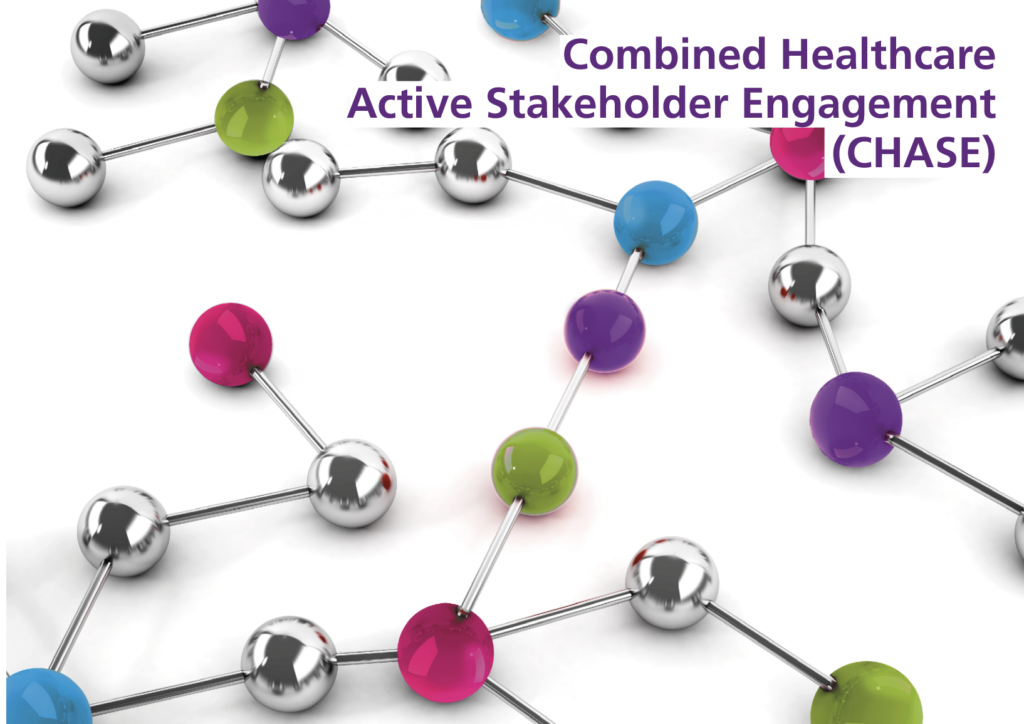
What’s the challenge?
Like a lot of organisations, more often than not, crucial knowledge and information about Combined’s stakeholders is duplicated or hidden from sight in users’ e-mail accounts, scattered directories and folders, or hundreds of spreadsheets, reports or presentations built up over the years.
In particular, insights and information about partners or stakeholders can typically be held by separate teams or divisions across the organisation or trapped in information silos.
Lots of organisations seek to get around this problem by subscribing to commercial sources of contacts, biographies and intelligence. But the problem with this approach is that the information held by these commercial sources is often too generic or untargeted to be of optimum use and, so, misses the mark when it comes to really delivering what the organisation needs. It also can represent poor value for money.
Also, organisations find it difficult to map their partner and stakeholder intelligence to specific services, desired results or multiple contexts and campaigns.
We look to solve this problem by:having all our key partner and stakeholder knowledge and information held securely in one place, reusable at the same time in different contexts or campaigns, many times over and accessible to all who need it;
- ensuring our campaign, partner and stakeholder intelligence is integrated across the Trust and easily understood;
- ensuring we hold only the specific targeted information about only the people or organisations we are interested in; and
- ensuring that our partner and stakeholder intelligence is clearly and intelligently mapped to specific desired results and multiple contexts and campaigns.
Dovetailing with the Trust’s new Partnering Strategy
Combined Healthcare has recently developed a new Partnering Strategy which details our commitment to working together with our core partners so we can have assurance that the services we provide meet the needs of our local population, are aligned to the services offered through our partners and benefit from service improvement opportunities which harnesses the breadth and depth of the expertise available through our partner network.
This Partnering Strategy sets out the principles and approaches we will use to support achievement of this objective.
- Our processes and mechanisms for engagement are appropriate and effective;
- Our services and use of healthcare resources are enhanced through collaboration with our partners; and
- Our partners have a closer, on-going relationship with the Trust, they feel involved and that their contribution is considered, valued and can make a difference.
To deliver partnership working successfully it is important to develop good formal and informal relationships that build trust and share responsibility, whilst respecting difference. To facilitate this, the Trust Partnering Strategy commits us to adopt the following principles in their dealings with partners:
- building trust and a mutual respect for each other’s roles and responsibilities;
- openness, honesty and transparency in communications;
- a top level commitment;
- a positive and constructive approach;
- commitment to work with and learn from each other;
- early discussion of emerging issues and maintaining dialogue on policy and priorities;
- commitment to ensuring high quality outcomes;
- where appropriate, confidentiality and agreed external positions;
- making the best use of resources; and
- ensuring a “no surprise” culture.
How we will work together with the Partnerships and Strategy team
The Communications and Engagement Team will work together and support the Board and the Partnerships and Strategy Team to jointly deliver the Partnering Strategy as part of our new CHASE programme. High level responsibilities will be:
The Board
- When attending events or networking with key stakeholders, promote and position NSCHT using our core messages &/or specific briefings provided by staff.
- Nominate Board level and/or sub-Board level leads to represent NSCHT with specific partners
- Provide regular focus and scrutiny on progress with and the effectiveness of partnership working through the Board, the Board Assurance Framework, and relevant Committees
- Lead by example in the promotion of core messages internally and externally
Partnerships & Strategy Team
- Monitor the effectiveness, of engagement across our priority partners
- Coordinate regular reports on progress in each of the priority areas for Board, Management board and relevant Committees.
- Develop, populate and keep up to date a trust wide partnership matrix
- Systemically use and review the list of core partners and our approaches in order to be proactive our relationships
- Record engagements to monitor our performance and impact
- Input to events, meetings and networks to follow through on specific plans.
- Regularly review opportunities for influence identified as a result of networking and horizon scanning.
- Lead by example in the promotion of key messages internally and externally
The Communications and Engagement Team
- Ensure our stakeholder and partner knowledge and information is maintained and kept up to date in an integrated fashion;
- Support the Partnerships and Strategy Team to enable them to update Trust wide partner and stakeholder intelligence;
- Develop and manage the trust-wide partnership matrix as an integrated component of our wider CHASE programme;
- Ensure that insights and knowledge gleaned from across the Trust’s wider engagement activities are made available to the Partnerships and Strategy Team to further enrich Partnering Strategy activity and effectiveness.
Using MOOD tool to underpin the integrated CHASE Programme, Partnering Strategy and Diversity and Inclusion Strategy.
Combined Healthcare has recently adopted and licensed MOOD as a powerful business analysis and stakeholder management solution. Mood delivers in one integrated package:
- A customer and stakeholder relationship management system;
- A polling and presentational tool;
- A policy and service pathways analyser;
- A strategy planner and delivery monitor; and
- A campaign designer and organiser.
Stakeholder and Engagement managers can use MOOD to:
- bring together and manage all stakeholder knowledge and intelligence in one place – with individual pages for each stakeholder person and organisation;
- update stakeholder details once and know that they are automatically updated everywhere they are used;
- build and present hierarchical message frameworks and apply them intelligently to individuals, organisations or groups;
- produce any number of targeted mailing and contact lists, with tailored messages for each audience;
- track and manage stakeholder interactions, combining internal and external comms activity; and
- intelligently analyse and track our engagement with Seldom Heard groups as part of our Diversity and Inclusion Strategy.
Campaign and Marketing managers can use MOOD to:
- bring together and manage all campaign knowledge and intelligence in one place
- update campaign target details once and know they automatically updated everywhere they are used;
- build and present campaign messages and map them individually to individuals, organisations or groups;
- use a specific visual mapping tool, called Desired Outcome Tracker to map and understand the current state of campaign progress, success and priorities; and
- track and manage campaign tasks and activities, combining internal and external teams’ activity.
Public Affairs Managers can use MOOD to:
- collate and integrate political stakeholder knowledge normally spread across multiple sources (e.g. Political or Organisational websites, Parliament.uk, DOD Online, Eurosource…);
- add organisation-specific intelligence (e.g. sites of services or operations, areas benefiting from organisational activity, or investment); and
- hone in on tailored sub-sets of that knowledge tightly focussed on the specific context and needs of the specific organisation (e.g. where it currently has operations or customers or where it wants to build a business development strategy
Partnerships and Relationship Manager
We will build a Combined CHASE Partnerships and Relationship Manager tool in MOOD.
This will display key information about each of our stakeholders, which we will build up through desktop research and conversations with Trust leaders and managers and in close collaboration with the Partnerships and Strategy Team.
We will develop Partnership and Relationship Manager pages for each of our key stakeholder organisations and individuals. This will be informed by:
- our stakeholder analysis set out in the previous section in this Review on Strategic Shift; and
- the analysis undertaken by the Partnerships and Strategy Team to develop the Partnering Strategy.
We will build the pages to include key knowledge and measures including:
- biographical details (where appropriate)
- roles and positions held;
- details of recent activity, events and engagement meetings and activities with Combined;
- reasons for interest to Combined;
- influence over decisions, strategies and services involving the Trust;
- degree of support for our perspectives; and
- strength of our relationship.
We will also capture on these pages the names of individuals carrying out in respect of each organisation or individual the following roles included in the Trust’s new Partnering Strategy. We will regularly make available to each of these individuals the most up to date Trust-wide knowledge and information about those for whom they play a role.
Role | Partnering Strategy Description |
Champion | An individual (or several individuals) who promote the partnership using their personal / professional reputation and / or role to give the partnership greater authority or profile |
Broker/Intermediary | An individual selected (either from one of the partner organisations or from outside the partnership) to act on behalf of the partners to build and strengthen the partnership especially in its early stages |
Manager | An individual appointed by the partnership on a paid basis to manage the partnership and / or the partnership project – especially once the partnership is established and is at the stage of project implementation |
Facilitator | An individual (usually external to the partnership) appointed to manage a specific aspect of the partnering process (e.g. a meeting set up to deal with a particular issue facing the partner group) |
Promoter | An individual, most likely a member of the partnership, who acts as an advocate for the partnership to others – a “champion” who argues the merits of the partnership on the basis of its track record rather than their own personal reputation |
Desired Outcome Trackers
MOOD includes the ability to manage and present any number of “Desired Outcome Trackers”. These provide matrix visual representations of selected key partner stakeholder individuals and organisations, showing the current state of our Trust-wide partner and stakeholder understanding in real time.
As a first step, we will use the Desired Outcome Tracker tool to build the new Partnering Strategy Matrix. It will plot each person and/or organisation on a 12 x 7 view of 2 indicators:
- their degree of support or opposition for our perspective; and
- their degree of Influence over decisions, strategies and services affecting the Trust
Multiplying these two indicators together will provide for each person or organisation their unique CHASE score.
We will be able to use this visual matrix to support the Partnerships and Strategy Team by helping them to identify where we need to concentrate our relationship building efforts, as well as tracking over time their development and strengthening.
We will, over time, develop further Desired Outcome Trackers for use in other business contexts, for example engagement with Seldom Heard Groups.
Integration with wider communications and engagement activities and strategy
Because we are using the MOOD tool to capture our wider communications and engagement activities – including being the data repository for our events planning, our LEAP Active Listening Programme, and the Trust’s Inclusion Action Plan – our integrated CHASE programme and Partnering Strategy will be fully integrated into our wider communications and engagement activities and strategies, including our Diversity and Inclusion Strategy.

